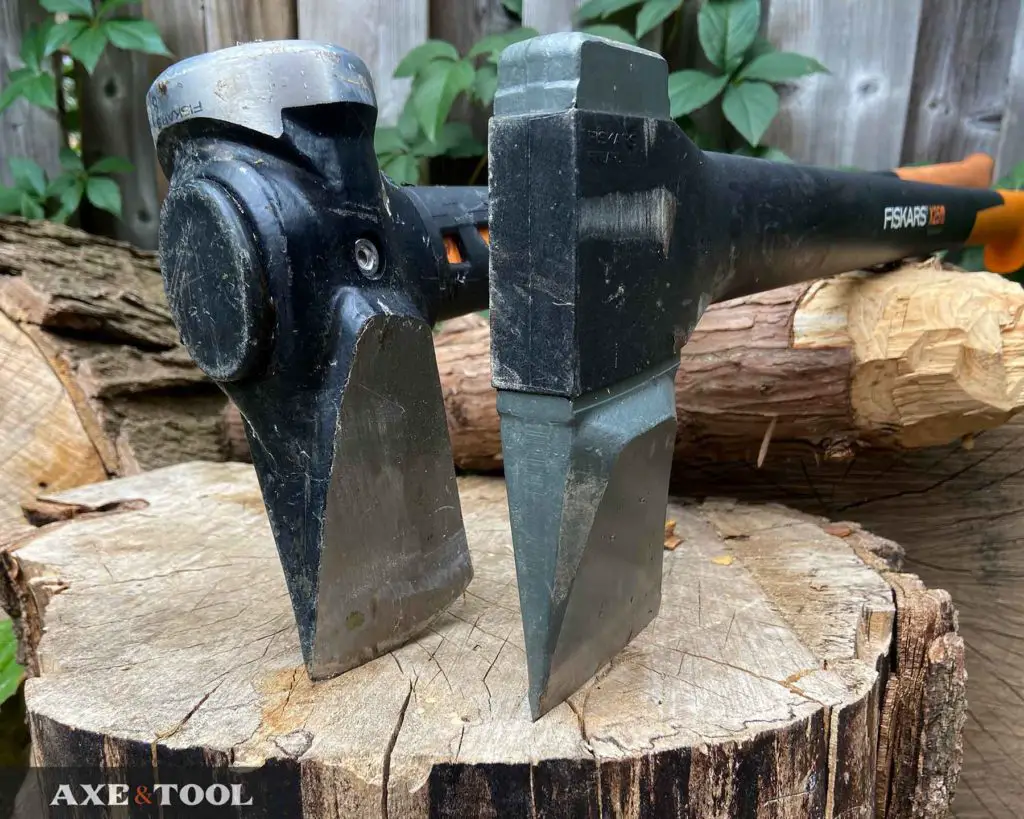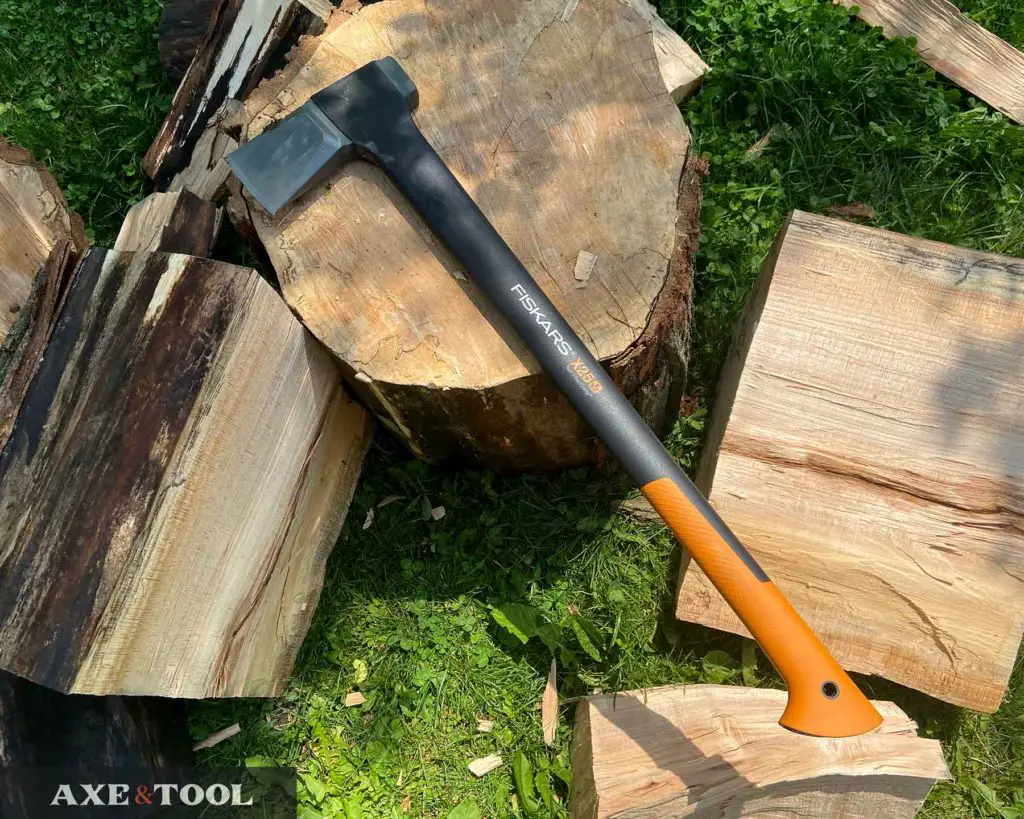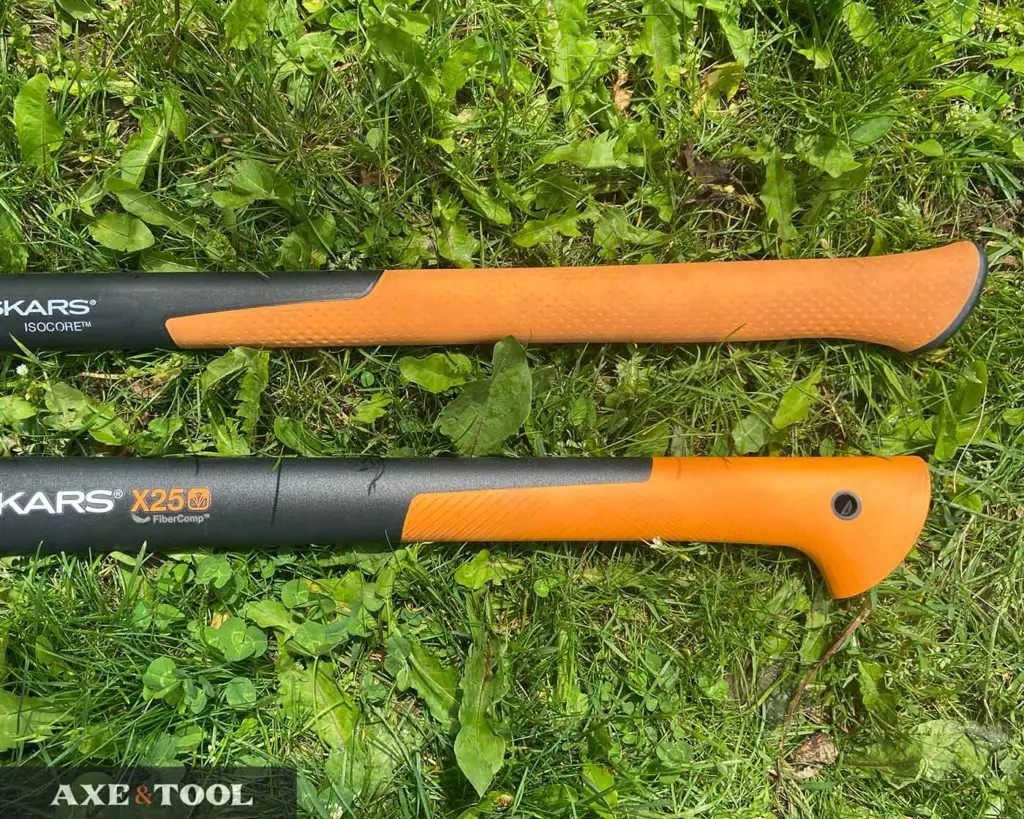Fiskars Splitting Axe vs IsoCore Maul – Which Do You Need?

When I started I didn’t know whether I needed a splitting axe or a maul – so I bought both. And, now that I’ve been using them I get the differences.
A splitting axe like the Fiskars X27 should be your main splitting tool. They can split large logs and be swung for hours. The IsoCore Maul supports the axe but is not for all-day use. But its weight and unique design can force apart the hardest wood and be used with splitting wedges.
I’ll elaborate on the differences further down, but here are the details at a glance:
| X27 | Maul | |
| Length | 36” | 36” |
| Head weight | 4lb | 8lb/6lb |
| Total weight | 5.65lb | 10lb/8lb |
| Cutting edge | Flat grind | Convex grind |
| Flare width | 1.6″ | 3″ |
| Handle | Hollow composite | Steel core composite |
| Grip | Over-mold | Padded over-mold |
| Head attached | Molded | Pinned |
| Sledgehammer safe | No | Yes |
| Use with wedges | No | Yes |
Both of these tools have a similar price, but the maul is usually about $5 cheaper. However, don’t go by price – go by what you need.
For comparison here is the X27 on Amazon, and here is the IsoCore Maul. The price is usually consistent between retailers because they are so widely available.
Why use a splitting axe and not a Maul?

The flared splitting axes can handle large logs
Big logs are no problem for the large Fiskars splitting axes.
The flared splitting head forces the grain apart, and the composite handle is great for prying stubborn wood apart (if needed).
They are capable of splitting 2+ foot logs in half but remember you don’t need to start in the middle. You can split off chunks around edges, working your way in.

Splitting axes are more efficient than mauls
Splitting big rounds is great, but most of the work comes in the following swings.
The axes are much easier to handle when splitting all the smaller pieces of wood. You need increasing accuracy as pieces of wood get smaller, and that is a lot easier with an axe than a heavy Maul.
I’m sure someone out there will say they swing the 8lb maul all day long “no problem”. If that’s true, good on ‘em, but what a waste of energy.
I typically recommend the X27 splitting axe. It offers the most power but is still quite light. Plus the 36″ handle is safest. See the X27 on Amazon.
However, I often grab the 28″ long X25 over the 36″ X27. While the X27 is more powerful (and popular) I find the shorter handle is more nimble around the woodpile. But the shorter length also makes the X25 more dangerous if used improperly.
But I also have the Maul for backup if I need it.
I have a good article with more details about how to pick the right Fiskars splitting axe.
When do you need the maul?
While the axes are great, it can certainly be useful to have a maul around for support.
Use a maul to split tough wood, then switch back to the axe
You can get some very tough wood that can leave your axe just bouncing off – or sticking in with little progress. So that’s where the Maul can step in to support.
If you have a lot of really large or tough logs you might start with the maul and split them all into more manageable pieces before switching to the axe.
Especially if (like me) you decide to make a smaller splitting axe your primary tool. Since the majority of the swings are happening once the largest pieces are broken apart.
See the IsoCore maul on Amazon.
Use the maul with wedges
If you have some really big pieces that require splitting wedges. The maul can double as a big sledgehammer to drive wedges in.
A maul should still not be hammered on if it gets stuck – but they will handle it much better than an axe. While they are hardened, they can still shatter and pieces can break off because both tools are so hard. Wedges on the other hand are deliberately softer than the maul, so it’s safe to use.
The axes have a small unhardened pole that will deform with hammering. More details on the differences are below.
Key differences between the axe and maul
There are some key differences between the Fiskars splitting axes and mauls other than just weight. These features also make these axes and maul some of the best on the market (especially for the price).
The axes have a sharp cutting edge
The axes come sharp with a 30-degree flat grind edge. Having a sharp edge can be useful even on a splitting axe for cutting through knotty or stringy wood.
The edge of the maul isn’t sharp, but it comes to a point with a stronger convex grind to concentrate the force. The maul relies on the power from the heavy head more than sharpness. The blade also has more curve to it than the axes to concentrate the force even further.
The maul has massive flared cheeks

Flared cheeks are great for a splitting device as they ramp the two sides of the wood out while reducing friction compared to standard a wedge shape.
The axes have nice big flared cheeks that ramp out to be 1.6 inches across at the widest point. But they also don’t cover the entire cheek of the axe, they taper back in.
These tapered edges give you a leverage point for the head to be twisted and rocked – either to free a stuck axe or pry apart some stubborn wood.
The maul just has massive flared cheeks that span 3 inches at the peak. It’s split or bust with the maul, but if it gets wedged into some stubborn wood you have another option.
You can use the maul as a sledgehammer
You can see there is quite a difference in the pole (back of the head).

On the Fiskars axes, the pole is small and not hardened. So it should not be used as or with a hammer. It would damage the axe.
The IsoCore mauls are a different story. It has a large 3-inch hardened pole that is designed to be walloped.
If the maul gets stuck, you can hammer on it with a sledgehammer to complete the splitting. Or you can hammer on metal splitting wedges to split large pieces of wood.
Differences in head attachment
The axe heads are molded into the composite handle with the handle wrapping all around it.
The maul head has the handle go through it like a traditional axe, but it’s got an extra securing pin that goes through the steel core of the handle. So it’s not going anywhere.
The handles are similar but different

The top handle is the maul, the bottom is the splitting axe.
The axe handles are hollow composite. They are strong and light and do a decent job of reducing vibration. The large flare at the bottom of the handle locks the axe in your hands making fast repetitive strikes easier.
The axe grips are coated with a thin orange rubber over-mold which is easier on the hands and is better in cold weather.
The all-black models just have a textured composite grip, but I recommend the X-series with the orange grip. It’s easier on the hands and only costs a couple of dollars more.
The maul handles have an outer composite layer that covers a steel core. The steel core is needed to handle the weight and impact of the large head. This hybrid solution reduces the perceived vibration over traditional maul handles but is worse than the Fiskars splitting axe.
The grip is much more heavily padded and rubberized to help with this.
If you found this post useful and are planning to buy on Amazon, please click the link for the IsoCore Maul or the Fiskars X27 Splitting Axe.
Please comment below If I missed something or if you have any questions. I do my best to respond to everyone.
About the author:
About the author:
Jim Bell | Site Creator
I’m just a guy who likes axes. I got tired of only finding crap websites, so I set out to build a better one myself.
I’m also on Instagram: @axeandtool


Each has their purpose and I use them together as every round is different.
Jim…
I’ve been trying to lay hands on a Fiskars IsoCore 8 lb. maul for several days. Just ran across your post a few minutes ago when, via the internet, I was trying to check nearby retailers I might have overlooked. I had to write. Though I’d already made up my mind days ago re. what I wanted, this is just plainly the best review and comparison I’ve read on these two Fiskars woodsplitters. And validates my own thinking. I have owned and used an X27 for several years, and absolutely love it. We heat entirely with wood. A friend brings me 4-8 ft. logs and I saw and split them into firewood lengths for the woodstove. About 4 cords per year. The X27 has been all the firewood splitter I needed. Until now. Late last winter he dropped off maybe 25 huge logs. “Here,” he said, ” I know you already have all the firewood cut you need for the rest of the year, but if you want these, they’re yours.” I’m Irish. I’m never going to turn down free wood. The trouble was, many of those logs (again. 4-8 feet long) were upwards of 40 inches in diameter! The biggest one is a measured 47 inches! Prime ash and maple. Incredibly heavy. My Stihl chainsaw with its 18 in. bar is not long enough to cut through those massive beasts, even when I manhandle them with my peavy and roll them a time or two…which is, of course, a real job in itself. So I’ve borrowed a neighbor’s longer saw, and I’m slowly cutting my way through the pile, making rounds that look like bus wheels! Alas, my beloved X27 is not up to finishing such material—not even when I “slab” my way around the chunks and use wedges. (Or maybe what’s left of my 75 year old carcass is just not man enough for such brutal work.) The wheels are heavy, solid, and the logs have had a full summer to dry and harden. Great firewood, but tough to work up. I decided after a few days of self abuse that I needed a serious maul. Given my liking for the X27, a Fiskars maul was unquestionably my choice. Anyway, I’ve been running around to our local hardware stores looking for the IsoCore 8 lb. maul. No luck. So my afternoon plan is to check out a few stores in a couple of rural towns 30 miles west of where I live (southwest Ohio). Anyway, just wanted to tell you how great your overview of the two was. No one has done a better piece.
If someone offers free firewood, the answer is always “yes”. No questions.
At that giant size, another option to consider is splitting wedges and a sledge hammer – especially if you can’t find the maul. The maul is good, but it might help to attack it from a few points at once with wedges.
Good luck with those monster rounds, and thanks for the great comment (loved reading it), and kind words.
Jim B….
I’ve resorted to wedges and a sledge—which work, sorta, though it’s slower plus you have to find or create that starting crack or entry point. And dang it! I just WANT that Fiskars splitting maul! Not that I particularly hope monster rounds will become all that frequent in my future. But, hey…free wood is free wood and you never know what might come your way. Gotta be prepared!
I was just at my local Ace Hardware two days ago and they had the 8 lb Isocore. I was glad I saw it in person because after holding the beast I decided it wasn’t what I needed. Ended up with the x25 splitting axe (had to go to Home Depot to find that) and I love it.
Yeah, an 8lb maul is no joke – and not what I want to be swinging for hours at a time. I almost never use it, even on big stuff. You can just work around the edges with a splitting axe and be just fine.
“I got tired of only finding crap websites” – so true! How can the company in the forefront of AI produce such crappy search results? The first 4 results from “splitting axe vs splitting maul” sounded like they were written by bots! Absolute garbage with no useful information to be had. Thanks for a thoughtful article from a real person. You helped me decide that my X25 is probably all I need for now.
Really appreciate the comment – It’s rough to see how well some of those sites do… glad you found my post useful. The X25 is a great choice (my fav), happy splittin’!
Kia ora! and thanks for a really useful and informative website. It has helped me decide that the Isocore maul isn’t what I need for everyday use, even though I get some really knotty wood to split. I’ll be off to get an X27 shortly.
Keep on axeing!
Richard (NZ)
Thanks, glad you found it useful. Feel free to let me know what you think after you get some swing time in – I tend to get fairly co-operative hardwood around here and have no idea what the wood down in NZ is like. Happy splitting!
HEY! Where’s the review of the IsoCore 2.5 lb Maul? I bought one last week, and I’m having trouble finding it’s niche.
Right now; it seems for a given size piece of wood, there is always an axe or hatchet that would do the job better. I still use it every day, but it’s always to try it out, not because I think it would be the best tool for the job.
On smaller pieces; where I would ordinarily use a light strike with a hatchet, if I use the same light strike with this maul; it just bounces off. Definitely a quirky tool.
That being said; I find that it DOES split wood far larger than you would expect.
Please let me know when you’ve had a chance to review it.
Hey John, that is one of the few I never bought – I saw it more as a demolition tool. The large hammer surface could be used for pounding on stubborn boards or something. Other companies like Estwing offer similar products for kindling, but I have never really understood why. Like you said, a hatchet tends to do the job just fine. And Fiskars has the X11 that works great.
But maybe I will have to give it a go anyway, lol.
Awww, ya gotta get one, to get the rest of the way down the rabbit hole 🤣
Oh boy, they are on sale at my local hardware store – it must be a sign. Down the rabbit hole we go 🤣
I caught the bug BAD! At home right now; I have the 2.5lb maul, the X25, the black 36″ Super Splitter, and the X17.
Tomorrow; the IsoCore 8lb maul is arriving, as well as the X7, and the X11.
Later this month, all the way from the UK; my X5! is supposed to be here!
I know, I know; what the “H” do you want one of those for? And my answer is: I don’t know, it hasn’t gotten here yet!
Relatively expensive toy I’ll admit…
Ha, it’s a slippery slope. I actually really like the X5 for hiking/backpacking, and I have talked to carvers who use them for rough shaping before they switch to a knife. So, lots of reasons to own one.
…do I REALLY want to get the 28″ splitting axe, and the 6lb maul? I have until the first of June to make up my mind.
They don’t sell the 6lb maul in my area – but both of those are passable in my opinion. I never go for the 28″ splitter over the X25.
To the axeandtool.com owner, Your posts are always a great source of knowledge.
Appreciate it, thanks!